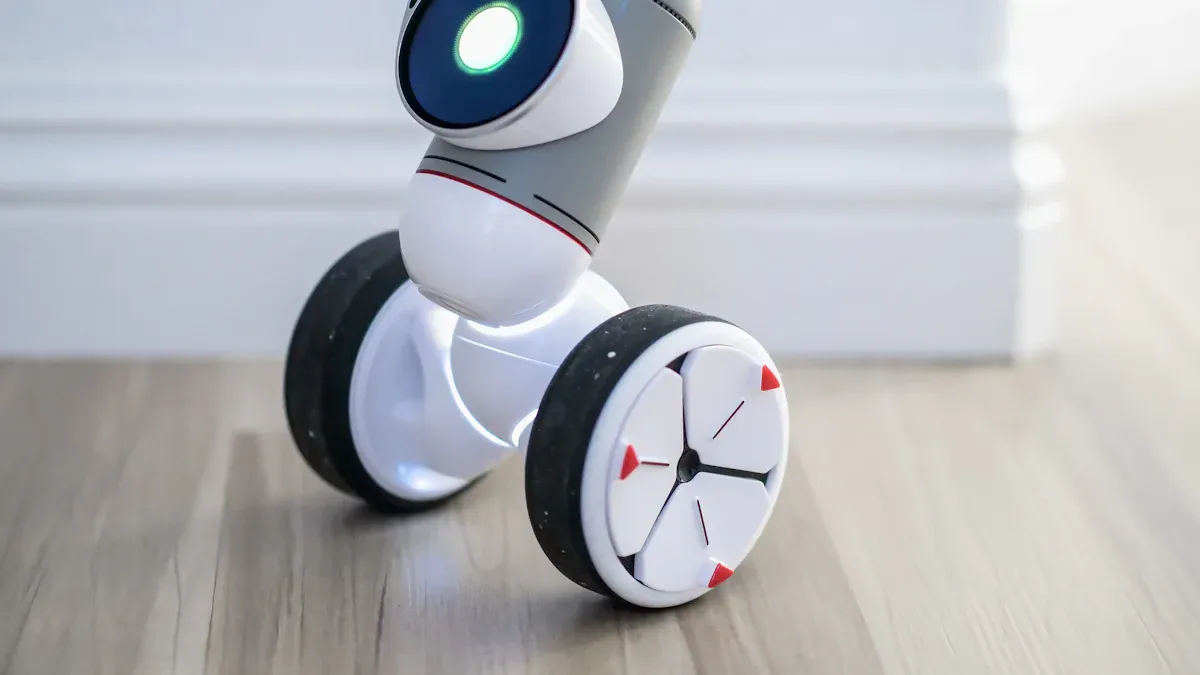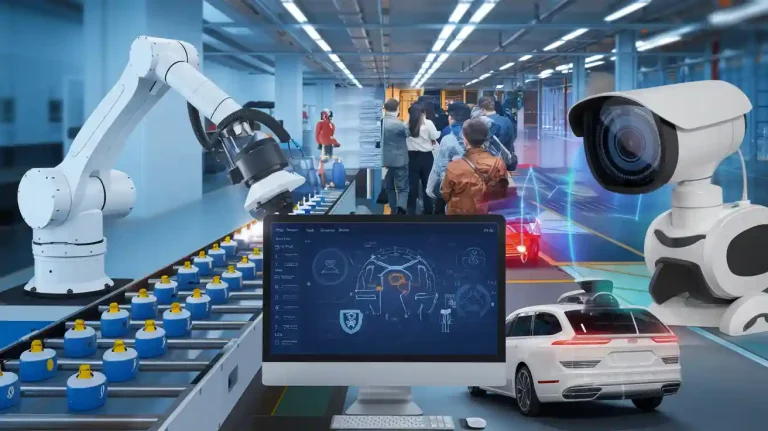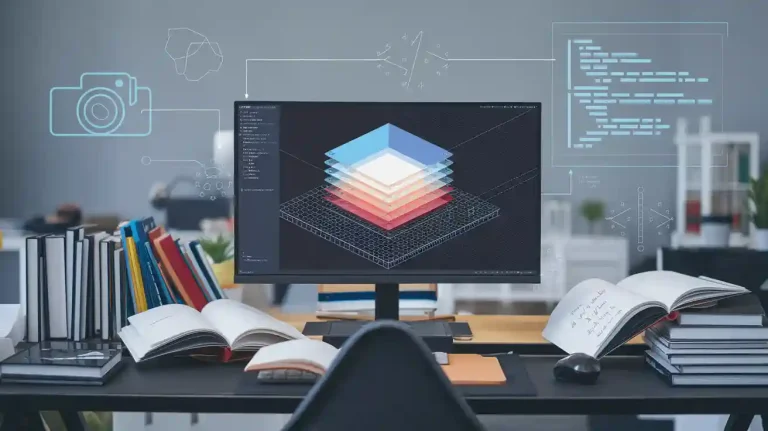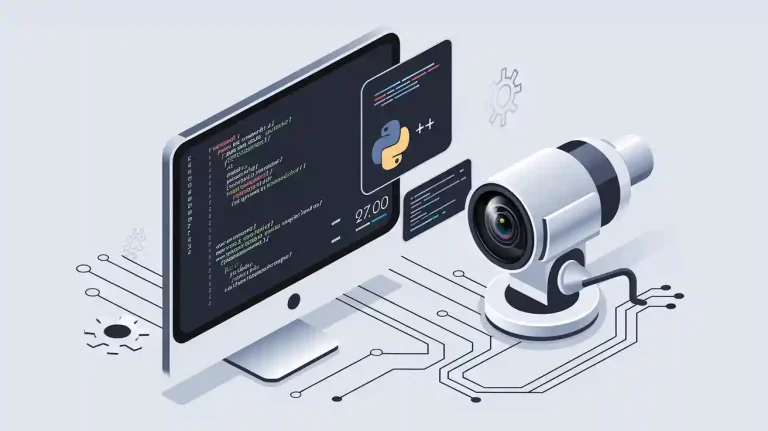
Time-of-flight sensors play a vital role in modern machine vision systems by capturing depth information with remarkable speed. ToF sensors measure the time light takes to travel to an object and back, enabling precise 3D imaging for tasks like robotic guidance and quality inspection. Many industries now depend on ToF technology, which offers real-time operation, robust performance, and a compact design. The global time of flight sensors machine vision system market reached $5.02 billion in 2024 and is projected to grow rapidly.
| Metric | Value |
|---|---|
| Market size in 2024 | USD 5.02 Billion |
| Projected market size by 2032 | USD 21.22 Billion |
| Largest regional market share | Asia Pacific |
- ToF sensors support 3D system growth by providing essential depth data.
- 3D imaging and depth sensing drive automation, quality control, and advanced robotics.
- ToF technology stands out for its ability to deliver accurate results, even in challenging environments.
- Time-of-flight sensors machine vision system adoption continues to accelerate across industries.
Key Takeaways
- Time-of-flight sensors measure distance by timing how long light takes to bounce back, creating fast and accurate 3D depth maps for machines.
- ToF sensors work well in many lighting conditions and provide real-time depth data, making them ideal for robotics, automation, and quality inspection.
- Compared to other methods like structured light and stereo vision, ToF sensors offer faster response, simpler design, and better performance in low light.
- ToF sensors face challenges like interference from sunlight and reflective surfaces, but engineers use filters and algorithms to improve accuracy.
- These sensors play a key role in industries such as robotics, factory automation, and autonomous navigation by enabling safe and efficient machine vision.
What Are Time-of-Flight Sensors?
Basic Concept
Time-of-flight sensors help machines see the world in three dimensions. These sensors use light to measure how far away objects are. ToF sensors send out a pulse or wave of light, usually in the near-infrared range, and then detect how long it takes for the light to bounce back from objects. The sensor calculates the distance by using the speed of light and the time it takes for the light to return. This process creates a map where each pixel shows how far away a point is, giving machines detailed depth information.
ToF technology stands out because it works well in many lighting conditions. It does not depend on the color or texture of objects. This makes it reliable for machine vision tasks in factories, warehouses, and robots. The time of flight sensors machine vision system uses these sensors to guide robots, check product quality, and help machines understand their surroundings.
The main parts of a time-of-flight sensor include:
- A sensor module that collects reflected light and turns it into depth data for each pixel.
- A light source, often a laser or LED, that sends out modulated light.
- A depth processor that changes the raw data into useful 3D images and filters out noise.
Tip: ToF sensors often use special optics and filters to focus on near-infrared light, which helps them work even when visible light changes.
How They Work
ToF sensors use two main methods to measure distance: pulsed modulation and continuous-wave (CW) modulation. In pulsed modulation, the sensor sends out short bursts of light and measures how long it takes for the light to return. In CW modulation, the sensor emits a steady wave of light and measures the phase shift between the sent and received signals. Both methods use the constant speed of light to calculate distance.
Here is how a typical ToF sensor works in a machine vision system:
- The sensor emits modulated light waves toward a scene.
- The light hits objects and reflects back to the sensor.
- The sensor detects the returning light and measures either the time delay or the phase shift.
- The depth processor calculates the distance for each pixel using the formula:
Distance = (Time of Flight × Speed of Light) ÷ 2 - The sensor creates a 3D depth map, where each pixel shows how far away a point is.
ToF sensors can achieve millimeter-level accuracy. They capture depth information for all pixels at once, making them fast and ideal for moving objects. For example, Sony’s DepthSense IMX556PLR sensor can capture 640×480 resolution at 30 frames per second with a working distance of up to 6 meters. Some sensors, like those from Panasonic, can even reach up to 250 meters for long-range tasks.
| Specification Aspect | Typical Range/Value |
|---|---|
| 3D Resolution (pixels) | 176 x 132 to 352 x 264 |
| Accuracy | ±4 to ±5 millimeters |
| Notes | Fast, scalable for robotics and quality control |
ToF technology keeps improving. New sensors can work in extreme temperatures and capture accurate 3D data even when objects move quickly. For example, Onsemi’s Hyperlux ID sensors use a global shutter and real-time processing to reduce motion blur. These advancements make ToF sensors even more useful for tasks like gesture recognition, access control, and industrial automation.
ToF sensors give machines the ability to see depth in real time. They help robots avoid obstacles, inspect products, and navigate complex spaces. The combination of speed, accuracy, and reliability makes ToF technology a key part of modern 3D machine vision.
Principles of 3D Machine Vision
Depth Sensing
Depth sensing forms the foundation of 3d machine vision. ToF sensors use time-of-flight technology to measure how long it takes for light to travel to an object and return. This process creates a 3d map of the scene, where each pixel holds depth information. By capturing 3d data point clouds, these sensors help machines understand the shape and position of objects in their environment.
- 3d imaging with tof sensors does not rely on the color or texture of objects.
- The sensors measure the phase shift or time delay at each pixel, which increases precision and reduces noise.
- Unlike spatial-domain methods, such as stereo vision or structured light, tof sensors use time-domain techniques for depth sensing.
- These sensors perform better at longer distances, often above 10 meters, making them ideal for large spaces.
Depth sensing improves machine vision by providing high-quality data for advanced processing. Machines use this data for tasks like coordinate transformation and filtering. This leads to better feature extraction and more accurate results in applications such as movement assessment and clinical evaluations. Tof sensors enable robots and automated vehicles to map their surroundings, plan paths, and detect obstacles using 3d data.
Real-Time Imaging
ToF sensors excel at real-time 3d imaging. They generate precise 3d point clouds within milliseconds, allowing machines to react quickly to changes in their environment. This speed supports tasks like spatial localization and shape reconstruction.
Real-time 3d imaging with tof sensors offers strong robustness, even in low-light or complex conditions.
The main advantages of real-time imaging with tof sensors include:
- Fast processing of depth information for immediate feedback.
- High data acquisition rates without moving parts.
- Stable operation in various lighting conditions due to active light emission.
- Simplified object detection and recognition, which reduces the computational load for AI systems.
| Advantage | Explanation |
|---|---|
| Accurate Depth Information | Tof sensors measure the time light travels, creating precise 3d depth maps for analysis. |
| Fast Real-Time Processing | They capture and process 3d data quickly, supporting dynamic applications. |
| High Data Acquisition Rate | Sensors collect large amounts of 3d data rapidly, suitable for complex environments. |
| No Need for Scanning Devices | Depth measurement occurs without moving parts, enabling real-time tracking. |
| Adaptability to Environments | Active light emission ensures stable 3d imaging in different lighting conditions. |
ToF sensors create 3d depth maps at high frame rates, which is critical for robot guidance, obstacle detection, and navigation. This technology allows machines to operate efficiently and safely in dynamic environments.
ToF vs. Other Methods
Structured Light
Structured light systems project patterns onto objects and analyze the way these patterns deform. This method creates highly detailed 3D models and excels in applications that require precision. Many engineers choose structured light for tasks like industrial inspection and quality control. However, these systems often need controlled lighting and careful calibration. They can become expensive due to complex hardware and setup.
Tof sensors offer a different approach. They measure depth by timing how long it takes for light to bounce back from surfaces. This method works quickly and adapts to changing lighting, including outdoor environments. Tof sensors usually cost less and have simpler designs. They provide fast data for real-time applications, though their resolution is lower than structured light.
Note: Structured light is best for high-precision tasks, while tof sensors shine in speed, flexibility, and cost-effectiveness.
| Parameter | Structured Light | Time-of-Flight (ToF) |
|---|---|---|
| Accuracy | High spatial resolution and precision | Medium resolution |
| Speed | Slower response time | Fast data acquisition |
| Cost | Higher, complex setup | More affordable, easy to implement |
| Lighting Suitability | Needs controlled lighting | Works in various lighting |
| Mechanical Complexity | More complex | Compact and simple |
Stereo Vision
Stereo vision uses two cameras to mimic human eyes. The system calculates depth by comparing images from different angles. This method works well in outdoor scenes with lots of texture. It is cost-effective and does not need special lighting. However, stereo vision relies on complex algorithms and struggles in low-light or low-texture environments.
Tof sensors use active infrared light to measure distance directly. They do not depend on scene texture or ambient light. These sensors deliver fast, real-time depth maps, making them ideal for robotics and automation. Tof sensors also perform better in low-light conditions and offer compact designs. While stereo vision can cover wide areas, tof sensors provide more reliable results in dynamic and challenging settings.
| Feature | Stereo Vision | Time-of-Flight (ToF) |
|---|---|---|
| Principle | Two cameras, image comparison | Emits light, measures return time |
| Software Complexity | High | Low |
| Accuracy | Centimeter-level | Millimeter to centimeter-level |
| Depth Range | Limited | Scalable, 0.5m to 5m+ |
| Low Light Performance | Weak | Good |
| Response Time | Medium | Fast |
| Compactness | Low | High |
Tof sensors lead the market in 3D imaging because they combine speed, adaptability, and cost savings. Ongoing research continues to improve their range, resolution, and integration with AI. As a result, tof sensors now appear in smartphones, vehicles, and robotics, driving rapid growth in machine vision technology.
Advantages & Challenges
Speed & Accuracy
ToF sensors deliver real-time 3D depth maps with high accuracy. These sensors emit modulated infrared light pulses and measure the time it takes for the light to reflect back. The system calculates distance using the speed of light and the time delay, often within nanoseconds. This process allows machines to capture depth data for every pixel at once, which avoids delays from scanning each point. As a result, ToF sensors provide fast response times and support high-speed industrial tasks.
Many industries rely on ToF sensors for precise obstacle avoidance, path planning, and situational awareness. For example, robots use these sensors to navigate busy factory floors, while cars use them for advanced driver-assistance systems. The sensors work well in different lighting conditions, including direct sunlight and low light. This robustness makes them valuable for both indoor and outdoor applications.
Key benefits of ToF sensors include:
- Real-time operation for immediate feedback and decision-making.
- High accuracy, often at the millimeter level.
- Fast response times, even in dynamic environments.
- Reliable performance in challenging lighting conditions.
- Compact and energy-efficient design.
ToF sensors help machines avoid obstacles, track objects, and interact with people safely and efficiently.
Integration in Machine Vision Sensors
Integrating ToF sensors into machine vision sensors requires careful planning. Engineers often combine different components, such as high-speed lasers and sensitive receivers, on a single platform. This approach improves switching speed and reduces the size of the sensor system. Many modern ToF sensors use phase-shift measurement models to achieve millimeter-range accuracy, which is critical for machine vision tasks.
Noise and unwanted signals can affect measurement quality. Designers use special circuits to reduce these effects and improve signal stability. Calibration is also important. Environmental factors like humidity and ambient light can change the signal-to-noise ratio, so systems must adjust for these changes in real time. Advanced ToF sensors use fast-switching devices and high-power lasers to increase pulse rates and improve measurement quality.
When building machine vision sensors, engineers must consider:
- Combining high-speed lasers and receivers for better performance.
- Using phase-shift models for precise distance measurements.
- Reducing noise and unwanted signals with special circuits.
- Calibrating for environmental changes, such as humidity and light.
- Using fast-switching devices for real-time 3D imaging.
ToF sensors often appear in compact modules, making them easy to add to robots, vehicles, and industrial machines. Their solid-state design means fewer moving parts, which increases reliability and reduces maintenance needs.
Limitations
Despite their many strengths, ToF sensors face several challenges in real-world applications. Environmental factors, such as strong sunlight or reflective surfaces, can interfere with sensor readings. High ambient lighting can saturate the sensor, raising noise levels and reducing measurement range and accuracy. Highly reflective or shiny surfaces may redirect the emitted light away from the receiver, causing errors or missing data.
ToF sensors also struggle with noise from electrical signals and interference from other light sources. These issues can lead to faulty or missing range data. Power limits, set for eye safety, can restrict the detection range of the sensors. In addition, ToF sensors often have lower spatial resolution compared to structured-light systems, which can affect image detail.
Common limitations include:
- Errors from photon shot noise, circuit noise, and multipath interference.
- Reduced accuracy in harsh weather, such as fog, snow, or rain.
- Difficulty measuring on shiny or dark surfaces.
- Lower spatial resolution than some other 3D imaging methods.
- Sensitivity to ambient light and environmental changes.
| Limitation | Impact on ToF Sensors |
|---|---|
| Ambient Light Interference | Reduces measurement accuracy and range |
| Reflective/Specular Surfaces | Causes depth voids or distorted readings |
| Noise and Crosstalk | Lowers accuracy, requires compensation algorithms |
| Power Restrictions | Limits detection range for safety reasons |
| Lower Spatial Resolution | Less detail compared to structured-light systems |
Note: Engineers use filters, adaptive gain control, and compensation algorithms to reduce these effects, but some challenges remain.
ToF sensors continue to improve, with new designs offering better resistance to noise and environmental changes. However, users must understand these limitations when choosing sensors for machine vision sensors in demanding settings.
Applications in Time of Flight Sensors Machine Vision System

Robotics & Automation
Robotics and automation rely on the time of flight sensors machine vision system for advanced 3d perception. These sensors help robots perform object detection, tracking, and recognition in real time. In logistics, robots use 3d imaging to measure parcels, boxes, and pallets, optimizing storage and transport. Autonomous mobile robots (AMRs) and automated guided vehicles (AGVs) use tof sensors for obstacle detection and localization. They can pick and place objects, even when millimeter-level accuracy is not required. High frame rates and dynamic range allow robots to handle fast-moving items and operate outdoors.
- Robots use 3d data to avoid obstacles and plan paths.
- Multi-camera fusion systems combine time of flight sensors with lidar for better 3d vision applications.
- Advanced models, such as Teledyne’s Hydra3D, offer high resolution and fast acquisition, supporting complex tasks.
ToF sensors enable robots to complete pick-and-drop cycles in about 500 milliseconds, making them ideal for high-speed automation.
Industrial Inspection
Factories use the time of flight sensors machine vision system to improve quality control and efficiency. These sensors provide non-contact, real-time 3d measurement of product dimensions and surfaces. They support object detection and tracking for defect identification and assembly verification. By creating detailed 3d maps, tof sensors help detect cracks, scratches, or assembly errors before products leave the line.
- ToF sensors operate in harsh environments, such as areas with dust or smoke.
- Integration with AI allows for automatic recognition and classification of defects.
- Real-time data collection speeds up inspection and reduces waste.
| Benefit | Description |
|---|---|
| 3D Mapping | Enables precise measurement and defect detection |
| Real-Time Assessment | Immediate feedback for quality control |
| Automation | Supports robotic inspection and assembly |
Autonomous Navigation
Autonomous navigation depends on 3d perception for safe movement. Time of flight sensors provide real-time, accurate distance measurements, allowing vehicles and robots to understand their surroundings. These sensors support localization, mapping, and obstacle avoidance. Unlike a 3d rgb camera, tof sensors do not need calibration and work in both bright and dark environments.
Autonomous driving systems use tof sensors for object detection, tracking, and recognition. They help vehicles identify pedestrians, other cars, and obstacles. In warehouses, robots use 3d data for mapping and navigation, improving efficiency and safety. ToF sensors also support odometry, helping robots track their position over time.
Time of flight sensors play a key role in autonomous driving by enabling real-time 3d imaging, object tracking, and reliable recognition, even in challenging conditions.
Time-of-flight sensors have transformed machine vision by enabling fast, accurate 3D depth mapping in real time. They work well in many lighting conditions and support tasks like obstacle detection, gesture recognition, and quality control. When choosing a ToF sensor, users should consider factors such as accuracy, resolution, environmental conditions, and system compatibility.
- Match sensor resolution and field of view to the application.
- Ensure integration with existing hardware and software.
- Test sensors in real-world conditions for reliability.
| Future Trend | Details |
|---|---|
| Accuracy improvements | Higher modulation frequencies and better processing |
| Broader applications | Robotics, automotive, AR/VR, and industrial uses |
ToF sensors offer a cost-effective and reliable solution for advanced 3D machine vision systems.
FAQ
What is the main advantage of using ToF sensors in machine vision?
ToF sensors provide fast and accurate 3D depth data. Machines can use this information to detect objects, measure distances, and navigate spaces in real time. This makes ToF sensors ideal for robotics and automation.
Can ToF sensors work in bright sunlight or dark environments?
Yes. ToF sensors use active infrared light, so they work in both bright and dark settings. They do not rely on ambient light, which helps them perform well outdoors and indoors.
How do ToF sensors compare to stereo vision systems?
ToF sensors measure distance directly using light travel time. Stereo vision uses two cameras and compares images. ToF sensors offer faster response and better performance in low-light or low-texture scenes.
What are some common challenges with ToF sensors?
Reflective surfaces, strong sunlight, and electrical noise can affect ToF sensor accuracy. Engineers use filters and algorithms to reduce these issues, but some challenges remain in harsh environments.
Where can engineers use ToF sensors in industry?
Engineers use ToF sensors in robotics, factory automation, quality inspection, and autonomous vehicles. These sensors help machines detect obstacles, measure objects, and guide movement safely.
See Also
Understanding The Role Of Cameras In Machine Vision
The Effect Of Frame Rate On Vision System Efficiency
Exploring Field Of View Importance In Vision Systems
Best Practices For Positioning Equipment In Vision Systems
Comparing Firmware-Based And Traditional Machine Vision Systems









